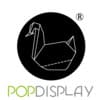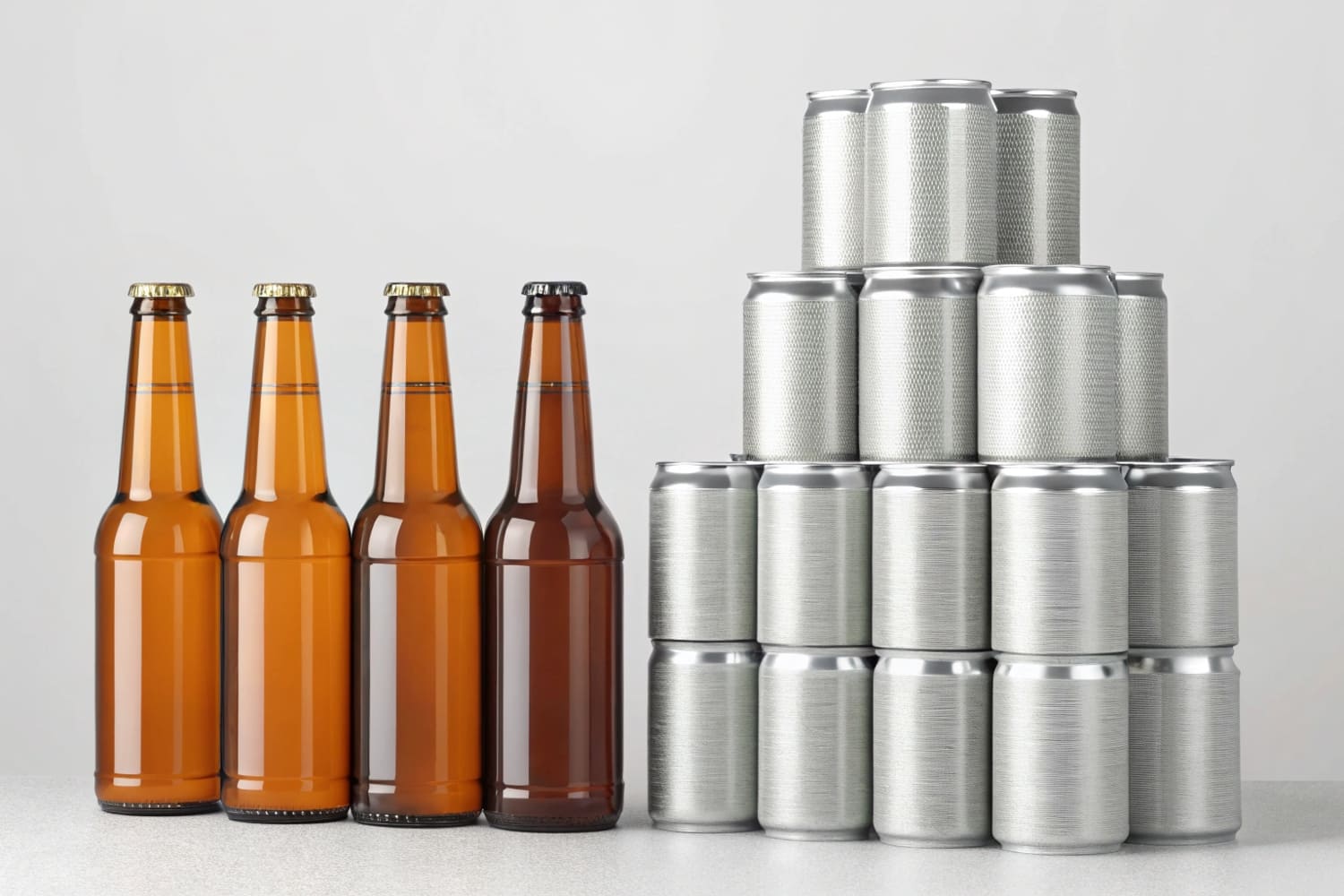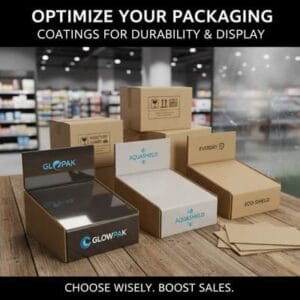ビールのパッケージはすぐに売れるもの、棚に並べた時の見栄えが良いもの、そして専門用語を使わずに明確な答えを求めるもの、これらが求められていることは承知しています。
はい。ボトルと缶の両方をご用意しており、それぞれの形状に合わせたカスタム段ボールディスプレイもご用意しています。販売目標、チャネルルール、サステナビリティ目標、輸送費、そしてスケジュールに合わせてお選びいただけるようお手伝いいたします。デザイン、サンプル、テスト、そして量産まで、すべて私が担当いたします。
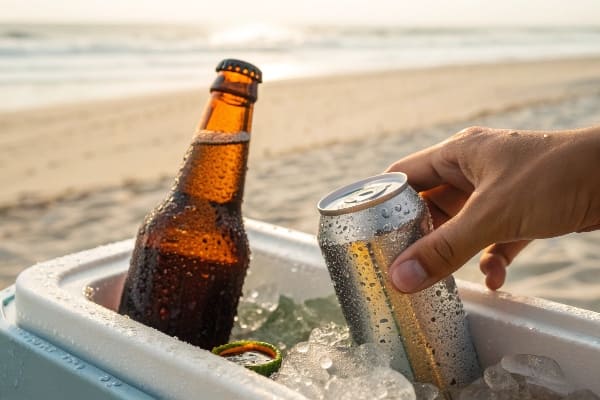
私は毎日ディスプレイの仕事に携わっています。買い物客の行動を観察し、コスト、運賃、小売ルールなどを把握しています。アドバイスは常にシンプルに、実際の発売期限を踏まえたものにしています。
缶とボトルではどちらが多く売れるでしょうか?
買い物客はしばしばスピードを重視します。小売業者はより安全な在庫管理を徹底し、マーケティング担当者は棚に魅力的な商品を並べたいと考えています。私はこれらの要素をまとめ、自信を持ってお選びいただけるようお手伝いします。
缶は冷えやすく、しっかりと積み重ねられ、大胆な 360 度のグラフィックが可能なため、通常、食料品店やコンビニエンス ストアでより多く売れます。一方、ガラス製品が品質と儀式を暗示するプレミアム チャネルやオンプレミス チャネルでは、ボトルが勝つ可能性があります。
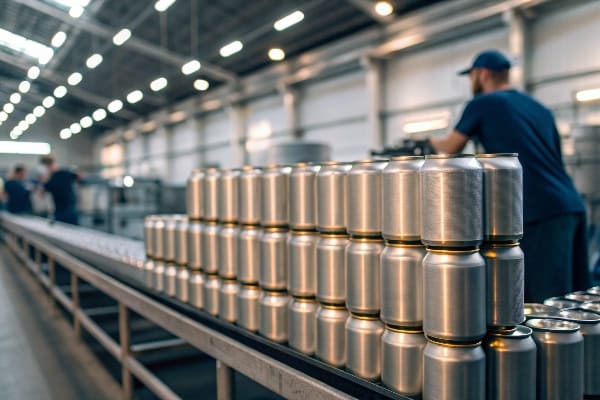
より深い分析:チャネル、コスト、買い物客のシグナル
高速流通チャネル全体に明確なパターンが見られます。スーパーマーケット、クラブストア、ガソリンスタンドでは缶の回転が速くなり、スタッフの補充も迅速化されます。パレットのキューブ化も効率化され、保冷ボックスはより多くの面材にフィットします。その結果、ピーク時の在庫状況が向上します。これだけでも売上は伸びます。グラフィックは缶に強い印象を与えます。フルラップはあらゆる角度からストーリーを伝えます。これは、混雑したビール売り場では重要です。
ボトルは依然として重要です。クラフト、輸入の伝統、そしてゆっくりと味わう喜びを象徴します。グラスを注ぐバー、テイスティングルーム、プレミアムギフトパックなど、様々なシーンで活躍します。ロングネックのボトルは、一部の購入者に愛される特別なスタイルを演出します。私は特定のフォーマットを強制することはありません。チャネル、価格帯、そしてブランドボイスに合わせてフォーマットを調整します。
以下は、通話を計画する際に私が使用する簡単な比較です。
| 要素 | 缶 | ボトル |
|---|---|---|
| 棚速度 | 食料品店、コンビニエンスストアでは高い | 一部のプレミアムセットではさらに高い |
| コールドチェーン | より速く冷やし、よりしっかりと積み重ねる | ゆっくり冷やす; 重い |
| グラフィックス | 360°フルラップ | ラベル+ガラスの美学 |
| 破損 | 非常に低い | より高い安全プロトコル |
| 貨物/キューブ | より良いキューブ、より軽い | より重く、より多くの空隙 |
| 持続可能性 | 高いリサイクル性、軽量 | リサイクル可能。一部の地域では詰め替え可能 |
ディスプレイをセットする際は、季節感を演出するために、缶はフロアPOPやパレットPOPと組み合わせます。ボトルは、カウンタートップディスプレイやギフト用の棚にテクスチャーのあるボードを組み合わせます。この組み合わせで、ボリュームとブランドイメージのバランスが取れています。
ビールは缶で買うべきか、瓶で買うべきか?
現実的な選択を迫られています。棚への迅速な納品と高い利益率を求めています。また、適切なブランドイメージも必要です。さらに、店舗の規制やフェスティバルのルールに直面する可能性もあります。現実的な視点でお話しします。
缶はスピード、物流、そして大胆なブランディングのために選び、ボトルはプレミアムキュー、ギフトセット、そして特定の店内での儀式のために選びます。多くのブランドは、缶をボリュームチャネルに、ボトルをプレミアムラインや季節のギフトにと、両方を活用しています。
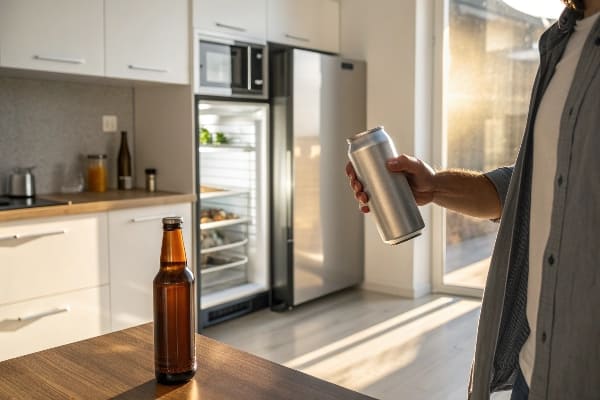
より深い分析:決定木1とディスプレイの統合
スコープ設定の電話会議では、シンプルな意思決定ツリーを使います。主要チャネルが食料品店、クラブ、コンビニエンスストアなどの場合、缶を優先します。粗利益がケース回転率の高さに依存する場合は、やはり缶が勝者です。ブランドストーリーが伝統やガラスの色にこだわっている場合は、ボトルを検討します。ローンチキットにギフトとしての魅力が必要な場合は、ボトルに印刷済みのケースと高級な棚トレイを組み合わせます。
陳列形式も重要です。私の工場では、段ボールでフロアディスプレイ、パレットディスプレイ、カウンタートップユニットを製造しています。缶はこれらのユニットに素早く積み込み、重量バランスを保ち、傾きを軽減します。ボトルにはインサートが必要で、公差も厳しくなります。そのため、コストと時間がかかります。ネックプロファイルを保持するためのダイラインを計画し、クラッシュロックベースを追加し、安全のためにベベルヘッダーも追加します。
POP ディスプレイ2 を合わせる方法は次のとおりです。
| ゴール | 推奨パッケージ | 推奨ディスプレイ | なぜ |
|---|---|---|---|
| 高速プロモーション | 12~24缶パック | パレットまたは床置きPOP | 迅速な補充、大きなフェイシング |
| プレミアム季節限定 | 4~6本入りボトル | カウンタートップまたは棚トレイ | ギフトに最適、触り心地が良い |
| 新しいフレーバーテスト | 洗練された缶 | PDQトレイ | 小さな設置面積、迅速なトライアル |
| オンプレミスサンプラー | ボトルミックスパック | コンパクトフロアタワー | 高級感、安全な仕切り |
必ず3Dレンダリングをお送りし、その後サンプルをお送りします。完璧になるまで無料で調整いたします。安全性を確認するために負荷テストを実施します。これにより、お客様のチームの混乱を防ぎ、納期を厳守できます。
100 ドル稼ぐにはビール缶が何本必要ですか?
デポジット運動やリサイクル活動の企画をされている方もいらっしゃるかもしれません。計算は明確かつシンプルにしたいですよね。そこで、一般的な2つのレートをご紹介します。
0.05ドルのデポジットで100ドルを受け取るには2,000缶が必要です。0.10ドルのデポジットで1,000缶が必要です。お住まいの州のプログラムの規則と対象となる容器をご確認ください。
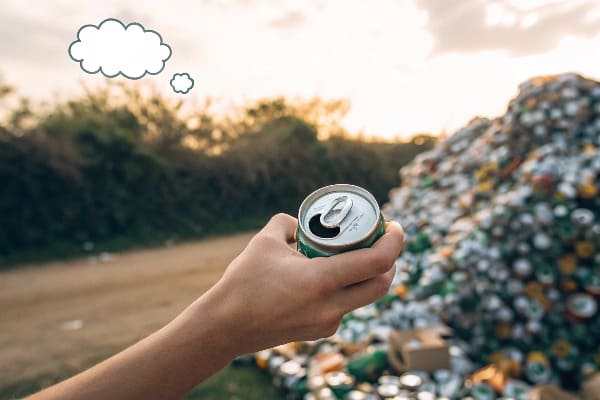
より深い分析:堆積物、重量、そして実際の収集
デポジットプログラム3は州によって異なります。対象となる容器1つにつき0.05ドルを支払うところもあれば、0.10ドルを支払うところもあります。明確な計算式は、チームがイベントを計画するのに役立ちます。また、現実的なソーシャルメディア投稿や社内KPIの設定にも役立ちます。ディスプレイヘッダーやネックハンガーに請求内容を印刷する前に、必ず現地の規則を確認してください。
重量も重要です。標準的な12オンスの空のアルミ缶4の重さは約13~15グラムです。1,000缶の重さは、袋の重量を除いて約13~15キログラムです。チームは2人1組で作業し、ローリングビンを使用すれば、安全に持ち上げることができます。私は、缶を平らにする方法、袋を置く場所、回収のスケジュールを記載したディスプレイとバックルームの標識をデザインしています。これにより、混乱が減り、店舗の満足度が向上します。
ここに簡単な参照があります:
| 缶あたりの保証金 | 缶100ドル | メモ |
|---|---|---|
| $0.10 | 1,000 | いくつかの州では一般的 |
| $0.05 | 2,000 | 多くの州で一般的 |
| デポジットなし | 該当なし | スクラップ価値を使用する。変動あり |
チャリティ活動を行う場合は、PDQトレイにQRコードを印刷できます。プログラムページへのリンクです。また、雨に濡れても持ちこたえられるよう、耐水コーティングを施すこともできます。シンプルで分かりやすいコピーが最適です。
ビールは缶ビールと瓶ビールのどちらを買ったほうがいいですか?
明確な答えを求めています。無駄や手間を減らしたい。そして、手に取った時や棚に並べた時に、ブランドイメージが際立つように見せたい。
「より良い」かどうかは、チャネル、ブランドのポジション、そしてコストによって異なります。缶は物流とスピードの面で勝ります。ボトルはプレミアムキューや特定の会場で有利です。私は、それぞれの選択肢が最適なチャネルで最大限に活かされるディスプレイを構築します。
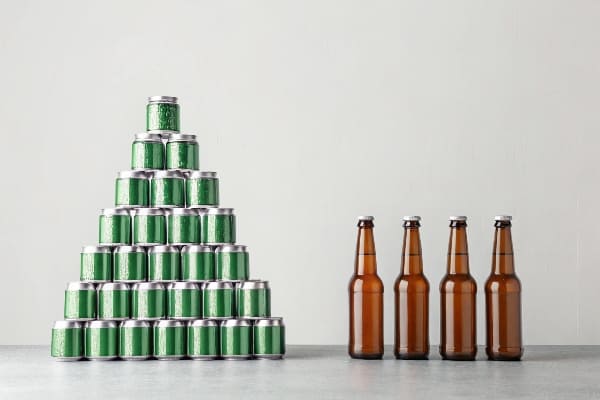
より深い分析:品質、持続可能性5 、タイムライン管理
「缶は味を損なうのでは?」という不安をよく耳にします。現代のライニングは風味を守ります。缶は光を透過しません。充填状態が良ければ酸素の吸収も少なくなります。ボトルも、光とキャップの品質をコントロールすれば完璧な味になります。本当の違いは物流にあります。缶は輸送費が軽くなります。つまり、輸送コストが下がり、ボトルの破損も減ります。ボトルはより保護性の高い包装と、運送業者による厳格な品質管理が必要です。私は強度試験を実施し、発売前に弱点を見つけ出しています。
持続可能性は一つのテーマではありません。アルミニウムはリサイクル率が高く、スクラップとしての価値も高いです。ガラスもリサイクル可能で、一部のプログラムでは詰め替え可能です。段ボール製のディスプレイは、さらに持続可能性を高めます。私はリサイクル可能な段ボール6 、水性インク、そしてフラットパックデザインを採用しています。これにより廃棄物を削減し、設置時間を短縮できます。ARコンテンツの説明が必要な場合は、QRコードを追加します。構造はシンプルなので、スタッフは工具を使わずに数分で組み立てることができます。
チームの連携を維持するための計画グリッドは次のとおりです。
| 寸法 | 缶 | ボトル | ヒントを表示します |
|---|---|---|---|
| 風味保護 | 良好(光なし) | 良好。琥珀色/紫外線制御が必要 | 窓の近くにシェードディスプレイ |
| 損害リスク | 低い | より高い | インサート、コーナーガードを追加する |
| 貨物費用 | より低い | より高い | フラットパックフロアPOPを使用する |
| ブランドキュー | モダンで大胆 | クラシック、プレミアム | ボードのテクスチャを合わせる |
| タイムライン | 速い | 適度 | ダイラインを早期に承認 |
スケジュールがタイトな場合は、迅速に対応します。概要をご説明後、24~48時間以内にレンダリング画像を共有します。白のサンプルをカットしてフィット感を確認します。色校正済みのプルーフで色を承認します。デザインが完成するまで、修正費用はいただきません。私の目標は、お客様の出荷日に間に合うスムーズなリリースです。
結論
缶はスピードとスケールを加速させ、ボトルはプレミアムな印象を与えます。最適なディスプレイとフォーマットを組み合わせることで、ストレスを軽減し、売上を伸ばすことができます。
意思決定ツリーを理解することで、パッケージ戦略が強化され、効果的な製品配置とマーケティングが保証されます。 ↩
POP ディスプレイのベストプラクティスを検討することで、顧客を引き付け、売上を伸ばす効果的なマーケティング戦略を作成するのに役立ちます。 ↩
デポジット プログラムを理解することで、リサイクルの取り組みとコミュニティの関与を最大限に高めることができます。 ↩
アルミ缶のリサイクルについて学び、持続可能性への取り組みを強化し、収集戦略を改善しましょう。 ↩
このリンクを参照して、パッケージ戦略を強化できる革新的な持続可能性の実践方法を見つけてください。 ↩
持続可能な梱包ソリューションにおけるリサイクル可能な段ボールの利点と用途について学びます。 ↩
